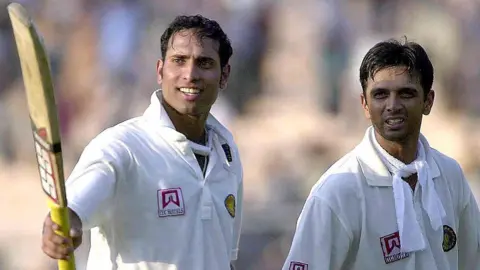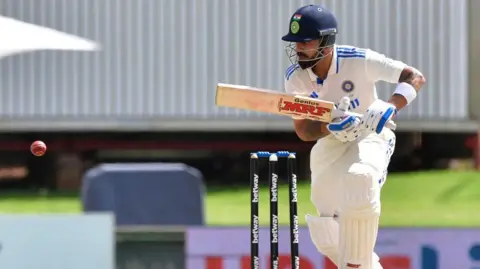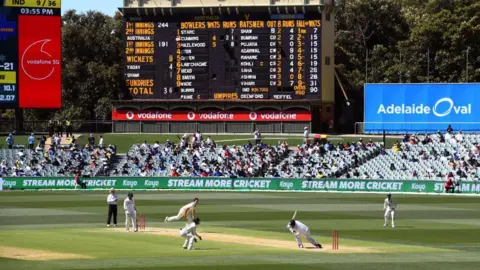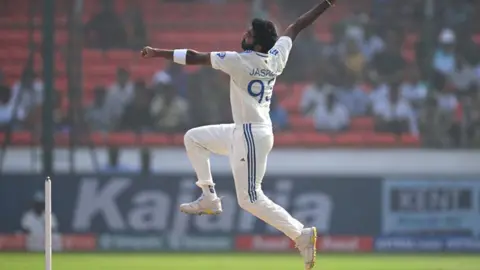 Getty Images
Getty ImagesMore than 90 years after India’s first Test match at Lord’s in 1932, Rohit Sharma’s team has made history. With a win over Bangladesh in Chennai last month, India now boasts more Test victories than losses, standing at 179 wins to 178 defeats across 580 Tests. Cricket writer Suresh Menon explores India’s remarkable transformation into a Test cricket powerhouse.
In every field of human endeavour, there are moments when circumstances and people align, sparking change.
In popular music this happened with the Beatles, where four boys emerged from the same place at the same time and created a new sound.
In sport, such changes are usually led by a single player who has around him a bunch who are almost as good. It happened in football with Pele as Brazil won three of four World Cups between 1958 and 1970 with him in the side.
With the arrival of a baby-faced Sachin Tendulkar, the fortunes of Indian cricket changed. His supporting cast was just as important to the transformation: Anil Kumble, Javagal Srinath, Zaheer Khan, Rahul Dravid, Virender Sehwag, VVS Laxman, Sourav Ganguly, Harbhajan Singh and MS Dhoni. Many would find a place in a team of all-time India greats.
Before Tendulkar’s debut in November 1989, India had won just 43 Tests and lost more than twice that number out of the 257 matches played. The remaining were draws.
In the Tendulkar era, India registered 78 wins against 60 losses out of the 217 matches played.
But it was a period when the number of draws – 79 – was still significant. Only seven wins had come in the “SANE” countries: South Africa, Australia, New Zealand and England. Draws in these countries were still seen as victory of sorts – the mindset with which India began international cricket.
Domestically, changes were happening. Led by Ganguly, and carried forward by Dhoni, India were discovering players beyond the traditional centres. If you were good enough, it didn’t matter where you were from; you would get your chance. This was despite the cricket board itself and the various local bodies often being drenched in politics.
Tendulkar retired in 2013, and since then India have won 58 while losing just 29 Tests of the 106 played. Significantly, there have been only 19 draws.
India won back-to-back series in Australia as they matched their rivals for aggression and in self-belief. This was no longer merely a cricketing change now, it was a psychological one.
Virat Kohli occasionally went beyond the pale as skipper, but he was passionate about Test cricket and passionate about winning – an attitude that seeped into the team.
Set to chase 364 in his first Test as captain in Adelaide in 2014, India nearly pulled it off and lost the match by just 48 runs.
It was a turning point. A new approach was created. Kohli, who led India in most Tests, at 68, was allergic to draws. It meant India played positive cricket at all times. Kohli drew just 16% of his Tests, the lowest among the top six captains in history. Even Clive Lloyd had 35% draws.
 Getty Images
Getty ImagesKohli had a talented bunch around him – Cheteswar Pujara, Ajinkya Rahane, Ravichandran Ashwin, Ishant Sharma, Ravindra Jadeja, KL Rahul. Again, players were discovered outside the traditional centres.
Another psychological change was that India no longer worshipped at the altar of orthodoxy. Effectiveness was more important than style. Jasprit Bumrah, who fast-tracked into international cricket, and is possibly India’s greatest fast bowler, might not have made it in earlier generations. He is unorthodox; coaches would have recommended some other profession.
The cricket board too finally began to react to regular defeats abroad – India lost all Tests to Australia and England in a six-month span in 2011-12.
The golden generation was retiring. Much was made of the ineffectiveness of domestic cricket. The board decided that pitches had to help quick bowlers. It instructed curators to retain 3mm to 8mm grass on pitches. The result over a period was two-fold. India discovered a group of talented fast bowlers while also ensuring the batters could play fast bowling better.
You needed fast bowlers to win abroad consistently. The low points of Indian cricket can usually be traced to their weakness against fast bowling. In Manchester in 1952, they were dismissed twice on the same day – for 58 and 82 – as Fred Trueman and Alec Bedser ran through the side.
In the “Summer of 42” at Lord’s in 1974, they folded for 42 thanks to Geoff Arnold’s and Chris Old’s dominant bowling. It gave rise to one of the most cruel cartoons in sport, with a woman telling her husband emerging from the toilet, “You should have gone home. Now you have missed the entire Indian innings.”
 AFP
AFPHowever, India’s dismissal for 36 at Adelaide in 2020 inspired neither cartoons nor panic. That was accepted as a freak innings where every good ball picked a wicket and there were hardly any bad balls. But it required great confidence to pass it off as one of those things – that confidence carried India to victories in two Tests that followed, and with it the series.
There was a phase, 2002-2004, when India won Tests at Port of Spain, Leeds, Adelaide, Multan and Rawalpindi. But only in Pakistan did they win the series. Veteran writer David Frith thought India then had the finest Top 6 batting line-up in the history of the game. There was both heft and elegance, a rare combination.
But that team did not live up to its potential. This is one of the ironies of Indian cricket – that their most celebrated team did not dominate as they should have.
What the current team has is heart. That 36 in Adelaide and 78 in Leeds serve to highlight the temperament of players who can let bygones be bygones and remember only the good times. It is a rare quality in an individual, even rarer in a team.
In the past, Indian teams always had a couple of outstanding individuals on whom everything rested. With Sunil Gavaskar dismissed, half the team was gone. If the great spinners were collared, there was no one to turn to until Kapil Dev came along, and if he had a bad day, that was that.
 Getty Images
Getty ImagesIn the 1960s, India won only one series abroad, in New Zealand. That helped consolidate India’s biggest strength: spin bowling. That most romanticised generation led by a Nawab, Mansur Ali Khan of Pataudi, with its essentially amateur spirit was necessary. Just as necessary was the one represented by Tendulkar, when India performed with greater consistency.
All this was before the Kohli-led bunch of professionals could emerge. When India were first ranked No.1 in 2009, they had not won a series in Australia, South Africa or Sri Lanka. Now only South Africa remains.
Indian cricket has moved on, and now we are looking at the end game of the recent stars: Virat Kohli, Rohit Sharma, Ravichandran Ashwin, Ravindra Jadeja. Already, Rishabh Pant, Bumrah, Shubhman Gill, Yashaswi Jaiswal and a host of emerging fast bowlers have indicated they are ready to take over. India play five Tests in Australia starting in November.
Suddenly the pressure is on Australia. The Tendulkar generation constructed a solid foundation, the Kohli-Sharma one has built on that. At the end of the Chennai Test against Bangladesh, India’s wins outstripped losses, 179-178 in 580 Tests. Statistical evidence of a new India, if such were needed.

